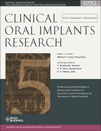Evidence-based knowledge on the biology and treatment of extraction sockets
Corresponding author:
Mauricio G. Araujo
Department of Dentistry
State University of Maringá
Parana, Brazil
Tel.: +41 44 634 32 51
Fax: +41 44 634 43 05
e-mail: [email protected]
Conflicts of interest:
The authors declare no conflict of interest.
Abstract
Objectives
The fresh extraction socket in the alveolar ridge represents a special challenge in everyday clinical practice. Maintenance of the hard and soft tissue envelope and a stable ridge volume were considered important aims to allow simplifying subsequent treatments and optimizing their outcomes in particular, when implants are planned to be placed.
Material and Methods:
Prior to the consensus meeting four comprehensive systematic reviews were written on two topics regarding ridge alteration and ridge preservation following tooth extraction and implant placement following tooth extraction. During the conference these manuscripts were discussed and accepted thereafter. Finally, consensus statements and recommendations were formulated.
Results:
The systematic reviews demonstrated that the alveolar ridge undergoes a mean horizontal reduction in width of 3.8 mm and a mean vertical reduction in height of 1.24 mm within 6 months after tooth extraction. The techniques aimed at ridge preservation encompassed two different approaches: i) maintaining the ridge profile, ii) enlarging the ridge profile. Regarding timing of implant placement the literature showed that immediate implant placement leads to high implant survival rates. This procedure is primarily recommended in premolar sites with low esthetic importance and favorable anatomy. In the esthetic zone, however, a high risk for mucosal recession was reported. Hence, it should only be used in stringently selected situations with lower risks and only by experienced clinicians. In molar sites a high need for soft and hard tissue augmentation was identified.
Conclusions:
Future research should clearly identify the clinical and patient benefits resulting from ridge preservation compared with traditional procedures. In addition, future research should also aim at better identifying parameters critical for positive treatment outcomes with immediate implants. The result of this procedure should be compared to early and late implant placement.




